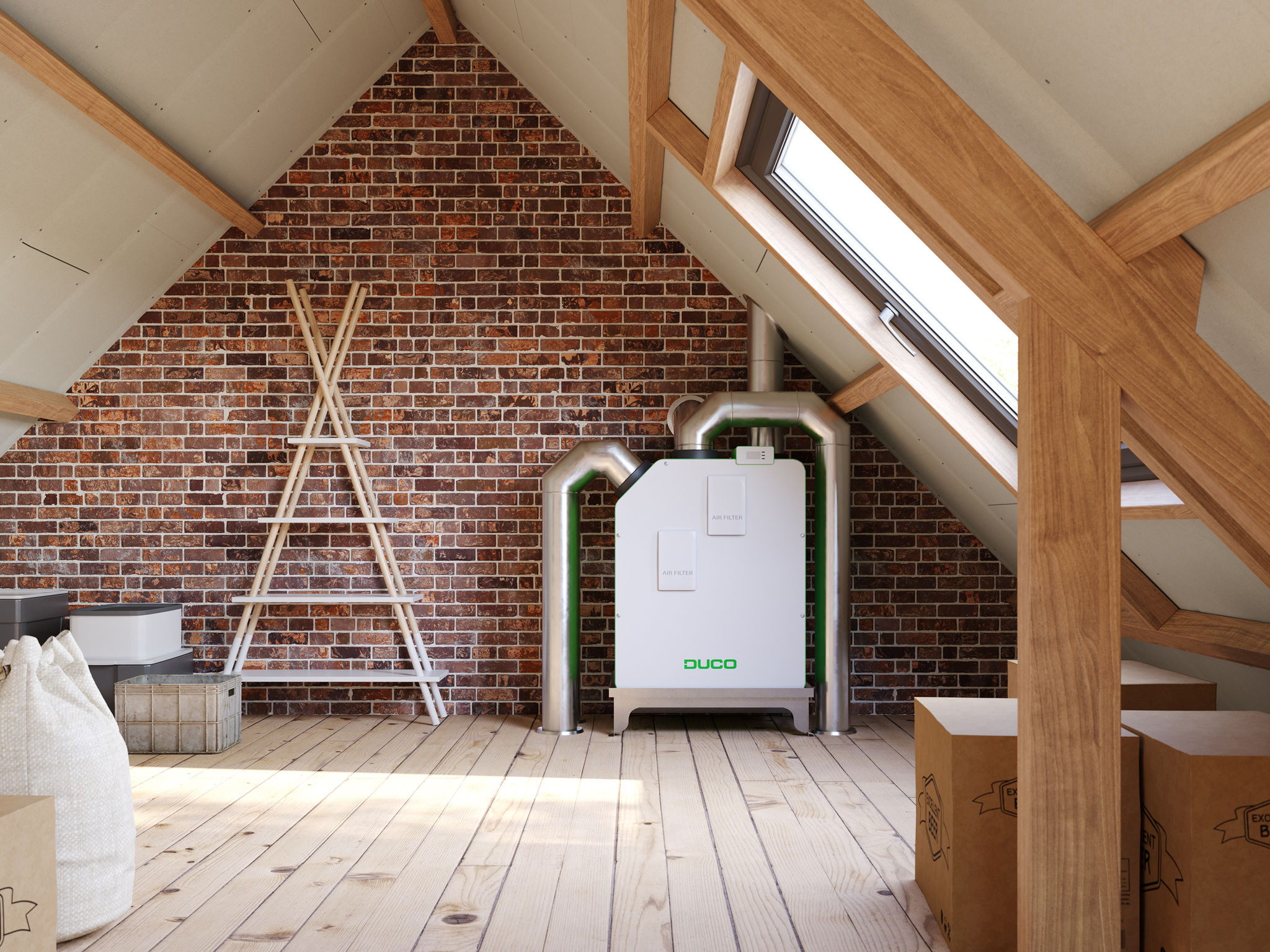Why is ventilation in homes needed?
While we work, cook, shower and sleep, indoor air quietly fills with moisture and pollutants. Without proper ventilation, this invisible build-up can harm both your health and your home.
What about just opening a window?
Opening a window to renew the air in your home leads to substantial thermal losses, letting heat escape in winter or cool air in summer. Once closed again, indoor air quality deteriorates very quickly. The most effective way to ensure healthy air without unnecessary energy loss is a controlled mechanical ventilation system. In well-insulated, airtight homes, mechanical ventilation is essential for renewing the air in a consistent and energy-efficient way, yet it’s often overlooked compared to heating or insulation.
Reasons why ventilation is a must in houses

1. Prevents moisture and condensation
Condensation occurs when humid air is cooled quickly. Moisture forms on windows, walls and other surfaces, resulting in mildew, dampness or mould. A ventilation system helps regulate temperature and controls moisture levels.

2. Helps improve asthma and respiratory problems
Ventilation helps reduce indoor air pollutants and excess moisture, which can trigger asthma, bronchitis, and other respiratory issues, promoting healthier indoor air quality.

3. Minimises reactions to pollution
Good ventilation combats the build up of pollutants, dust, and CO₂, which can lead to skin irritation, respiratory issues, fatigue, and headaches.

4. Lowers the risk of VOC and other chemical dangers
Volatile organic compounds (VOCs) from household chemicals and carbon monoxide from gas appliances can be harmful in high amounts. Proper storage and good ventilation help reduce these risks.

5. Extends the lifespan of your home
Excess moisture can damage building materials over time, leading to costly repairs. Good ventilation helps prevent this by reducing damp and condensation, protecting your home’s structure and surfaces.

6. Helps reduce energy bills
Ventilation systems with heat recovery extract warmth from stale indoor air before it leaves your home. This reduces heat loss and improves energy efficiency, helping you save up to 30%* on heating costs.
*According to the European Ventilation Industry Association.
What is a heat recovery ventilation unit after all and how would it work in my house?
A heat recovery ventilation system works for your whole home, extracting stale air from the home and bringing in fresh, filtered air with minimal heat losses.
Heat recovery ventilation systems transfer heat or cold from outgoing air to incoming air, minimising heat loss in the winter and heat gain in the summer. Demand-controlled ventilation systems adjust ventilation rates based on occupancy levels and air quality measurements, optimising the energy usage of an adequate ventilation.

How does a ventilation system work?
Here are the steps of how the system works broken down into four simple steps

1. Air intake
Fresh air is drawn in and filtered, removing pollutants and allergens

2. Air extraction
Stale, moist air is extracted from rooms via the extract ducts

3. Heat recovery
Both airflows pass through a heat exchanger, recovering heat

4. Air distribution
Warmed, fresh, filtered air is distributed to living areas via discrete supply valves in the ceiling
The top benefits that come with a heat recovery ventilation unit
- Improved indoor air quality
- Healthier indoor environment
- Prolongs your home's life
- Lower energy bills
Fresh home and healthier living
Fresh air circulation helps remove indoor air pollutants and prevent the buildup of harmful substances. This leads to a healthier living space by reducing allergens and respiratory issues caused by poor air quality.

Prevents excess moisture and dampness in the house
Adequate ventilation reduces indoor moisture levels, preventing mould growth, dampness, and related health problems. This helps maintain a safer and more comfortable home environment.

Extends the lifespan of your home
By controlling moisture buildup, good ventilation protects your home’s building materials from damage, reducing maintenance costs and extending the life of the structure.

Cuts costs and improves efficiency
Modern ventilation systems recover heat from outgoing air, reducing heat loss and improving energy efficiency. This can lower heating costs by up to 30%(2), making your home more cost-effective and environmentally friendly.
(2) Calculated according to the French administration’s energy saving certificate scheme (relative to humidity demand control ventilation BAR-TH-127)

Heat recovery ventilation unit myth buster

Mechanical ventilation wastes energy – or does it save it?
No, on the contrary, households can save up to 26% of their heating costs by using energy-efficient ventilation systems.
Adequate air renewal through a well-functioning mechanical ventilation system not only contributes to keeping people healthy and mitigating the financial risks of poor IAQ, but it also allows significant environmental benefits. Buildings account for approximately 40% of the EU’s overall energy consumption and 36% of the EU’s overall emissions of greenhouse gas3.
As outlined above, mechanical ventilation systems limit thermal losses and optimise heating and cooling needs, thereby improving the overall energy performance of a building, and allowing households to save on these costs. In fact, buildings fitted with a mechanical ventilation system can reduce energy needs by between 15 and 26%1.

Do ventilation systems with heat recovery and air conditioning do the same thing?
No. A common misconception is that ventilation systems with heat recovery (also called MVHR – Mechanical Ventilation with Heat Recovery) and air conditioning perform the same function. While both improve comfort indoors, they serve entirely different purposes. MVHR focuses on ventilation and heat recovery, ensuring fresh air and energy efficiency, while air conditioning is designed primarily for temperature control.
In fact, a heat recovery ventilation unit is a great complimentary solution next to your Daikin heat pump. Pairing a heat pump with an heat recovery ventilation unit enhances overall efficiency. The HRV captures the heat energy from the outgoing air, warming the incoming air before it reaches the heat pump system. This reduces the workload on the heat pump and helps maintain balanced indoor air quality.
Discover our ventilation systems
Featuring DUCO technology, our heat recovery ventilation systems offer intelligent, energy-efficient integrated solutions for every type of home






















